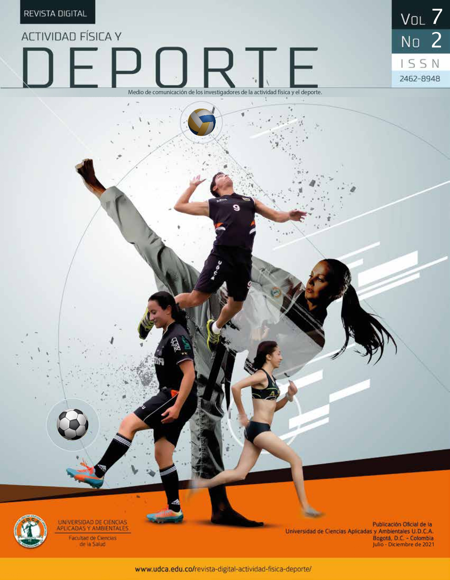Sports injuries in mexican diving team between the Central American and Caribbean Games 2018, and Pan American Games 2019
Lesiones deportivas en la selección mexicana de clavados entre los Juegos Centroamericanos y del Caribe 2018, y los Juegos Panamericanos 2019
Main Article Content
Abstract
Introduction: Currently there are few studies on the frequency of sports injuries in the diving discipline in Mexico, though they could be used in the development of protocols that help to reduce risk factors in this practice. Objective: The purpose of this research is to determinate the frequency of sports injuries in the Mexican diving team, during the period from June 14, 2018 to August 14, 2019. Methodology: A quantitative, retrospective, longitudinal and descriptive data of the team, through the study of the frequency with the Excel program and the graphic representation of the information obtained. Results: In the period examined, there were 74 injuries in total (n = 74): 84% of them were non-traumatic and 74% occurred during training (62 and 55 incidents, respectively). Regarding the type of injuries, 51% were caused in the Olympic test of 3-meter diving board, 22% affected the anatomical area of the shoulder and 34% the tendon tissue. Most of the cases occurred in male athletes (57%) and in those with less sporting experience (58%). Conclusions: The results obtained in this study are consistent with the incidence described in the international literature, and the information on the frequency of injuries in Mexican divers could be used for future studies, but use a rigorous methodology for the data collection process, select a bigger sample and define a longer period of time would be recommended.
Keywords:
Downloads
Publication Facts
Reviewer profiles N/A
Author statements
- Academic society
- Universidad de Ciencias Aplicadas UDCA
- Publisher
- Universidad de Ciencias Aplicadas y Ambientales U.D.C.A
Article Details
References (SEE)
BADMAN, B.L:; RECHTINE, G.R. 2004. Spinal injury considerations in the competitive diver: A case report and review of the literature. The Spine Journal. 4(5):584-590. https://doi.org/10.1016/j.spinee.2004.03.002
BARANTO, A.; HELLSTRÖM, M.; NYMAN, R.; LUNDIN, O.; SWÄRD, L. 2006. Back pain and degenerative abnormalities in the spine of young elite divers 5-year follow-up magnetic resonance imaging study. Knee Surgery, Sports Traumatology, Arthroscopy.14:907-914. https://doi.org/10.1007/s00167-005-0032-3
BECK, A. 2020. The incidence of scapholunate ligament disruption in competitive divers. British Journal of Sports Medicine. 54(suppl. 1):A51-A51.
ENGEBRETSEN, L.; SOLIGARD, T.; STEFFEN, K.; ALONSO, J.M.; AUBRY, M.; BUDGETT, R.; DVORAK, J.; JEGATHESAN, M.; MEEUWISSE, W.H.; MOUNTJOY, M.; PALMER-GREEN, D.; VANHEGAN, I.; RENSTRÖM, P.A. 2013. Sports injuries and illnesses during the London Summer Olympic Games 2012. British Journal of Sports Medicine. 47(7):407-414. https://doi.org/10.1136/bjsports-2013-092380
FEDERACIÓN INTERNACIONAL DE NATACIÓN, FINA. 2017. Reglas de Clavados FINA. Disponible desde Internet en: https://www.fina.org/content/fina-rules-regulations
FEDERACIÓN MEXICANA DE NATACIÓN, FMN. 2017. Reglamento Deportivo. Disciplina de Clavados. Disponible desde Internet en: http://fmn.org.mx/page/clavados
HAASE, S.C. 2017. Management. of upper extremity injury in divers. Hand Clinics. 33(1):73-80. https://doi.org/10.1016/j.hcl.2016.08.017
KERR, Z.; BAUGH, C.M.; HIBBERD, E.; SNOOK, E.; HAYDEN, R.; DOMPIER, T. 2015. Epidemiology of National Collegiate Athletic Association men’s and women’s swimming and diving injuries from 2009/2010 to 2013/2014. British Journal of Sports Medicine. 49:465-471. https://doi.org/10.1136/bjsports-2014-094423
MOUNTJOY, M.; JUNGE, A.; ALONSO, J.M.; ENGEBRETSEN, L.; DRAGAN, I.; GERRARD, D.; KOUIDRI, M.; LUEBS, E.; MORADI, F.; DVORAK, J. 2010. Sports injuries and illnesses in the 2009 FINA World Championships (Aquatics). British Journal of Sports Medicine. 44:522-527. https://doi.org/10.1136/bjsm.2010.071720
MOUNTJOY, M.; JUNGE, A.; BENJAMEN, S.; BOYD, K.; DIOP, M.; GERRARD, D.; VAN DEN HOOGENBAND, C.R.; MARKS, S.; MARTINEZ-RUIZ, E.; MILLER, J.; NANOUSIS, K.; SHAHPAR, F.M.; VELOSO, J.; VAN MECHELEN, W.; VERHAGEN, E. 2015. Competing with injuries: Injuries prior to and during the 15th FINA World Championships 2013 (aquatics). British Journal of Sports Medicine. 49(1):37-43. https://doi.org/10.1136/bjsports-2014-093991
NARITA, T.; KANEOKA, K.; TAKEMURA, M.; SAKATA, Y.; NOMURA, T.; MIYAKAWA, S. 2014. Critical factors for the prevention of low back pain in elite junior divers. British Journal of Sports Medicine. 48:919-923. http://dx.doi.org/10.1136/bjsports-2012-091875
RUBIN, B. 1999. The basics of competitive Diving and its Injuries. Clinics in Sports Medicine. 18:296-302. https://doi.org/10.1016/s0278-5919(05)70145-9
SOLIGARD, T.; STEFFEN, K.; PALMER, D.; ALONSO, J.M.; BARH, R.; DIAS LOPES, A.; DVORAK, J.; GRANT, M.E.; MEENWISSE, W.; MOUNTJOY, M.; PENA COSTA, L.O.; SALMINA, N.; BUDGETT, R.; ENGEBRETSEN, L. 2017. Sports injury and illness incidence in the Rio de Janeiro 2016 Olympic Summer Games: A prospective study of 11274 athletes from 207 countries. British Journal of Sports Medicine. 51(17):1265-1271. https://doi.org/10.1136/bjsports-2017-097956
STEINBRÜCK, K.; PAESLACK, V. 1980. Analysis of 139 Injuries due to accidents in water sport. Paraplegia. 18(2):86-93. https://doi.org/10.1038/sc.1980.14
VIEIRA, A.; ALEX, S.; MARTORELLI, A.; BROWN, L.E.; MOREIRA, R.; BOTTARO, M. 2017. Lower-extremity isokinetic strength ratios of elite springboard and platform diving athletes. The Physician and Sports Medicine. 45:87-91. https://doi.org/10.1080/00913847.2017.1302310
WATSON, A. 1997. Sports injuries: incidence, causes, prevention. Physical Therapy Reviews. 2(3):135-51. https://doi.org/10.1179/ptr.1997.2.3.135









